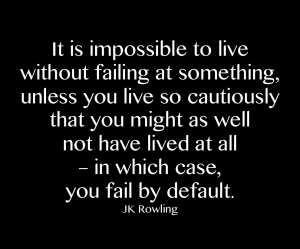 Have you ever seen an adult cyclist, dressed head to toe in spandex, go for a ride … with training wheels? Of course not! Kids use training wheels to learn how to ride, but eventually the training wheels have to come off. Falling and failing is part of what it takes to become a skilled and competent rider.
Have you ever seen an adult cyclist, dressed head to toe in spandex, go for a ride … with training wheels? Of course not! Kids use training wheels to learn how to ride, but eventually the training wheels have to come off. Falling and failing is part of what it takes to become a skilled and competent rider.
None of us are perfect and each of us makes mistakes that may lead to failure. Actually, Failure is a powerful teacher.
Did you know that potato chips, Post-It Notes, pacemakers, penicillin and Silly Putty are all outcomes of mistakes. In each case, the inventor was attempting to create something completely different and thought that he had failed with the final product. These so-called failures are actually triumphs.
As leaders, it’s tempting to enforce rules as we want results, and the only way we know how to get it is by being in control. But this neither creates engaged employees nor scales.
Failure, mistakes, mishaps — these play a vital role in helping employees learn and grow, too. Unfortunately, organisations and leaders do not take very kindly to mistakes and create employees who are risk-averse and too nervous to push boundaries and try anything new. The best companies and admired leaders are those that create an open, empowered culture of embracing and exploring the ‘new think’ and seeing failure as an opportunity to learn, grow and innovate.
In the words of #ElonMusk, let you teams know,
“Failure is an option here. If things are not failing, you are not innovating enough.”
My argument here is, ALLOW YOUR TEAM TO FAIL
When as leaders, we “allow people to fail,” it’s a way of trusting and empowering our people, letting go of the details, listening to them and taking a step back. So how do you do it?
Give Clarity, Listen & Be There
Give your team enough clarity on outcomes, set the purpose, empower and connect people to create a network where strengths and capabilities find each other to avoid disaster and enough room to try, fail, and learn.
But most importantly listen to your team, taking their counsel even if it means a step back from your plan, even if it means a loss to business. It may save you from a reputational risk or crisis that you may not be able to foresee but the expert in your team sees. History shows that many business catastrophes could have been avoided only if leaders were willing to listen to their teams and take their counsel.
Things will sometimes go wrong, and when they do, it’s important you remain calm. Do the right thing despite anxiety taking form. You’ll find a way through the crisis. On the way catching a glimpse of the greatness of calm and doing the right thing. As a good leader, be there to back your team, boost them up and give them the confidence to move forward.
Make “room for error”
Establish an open and optimistic culture in your team which builds confidence, an a-political environment, team spirit, encourages team members not to hide their mistakes and “be outstanding’.
Reprimanding someone for making a mistake is like punishing someone for sneezing. Mistakes are inevitable. What is not inevitable is identifying mistakes and learning from them.
A better way: Blameless Retrospectives
When a mistake occurs, don’t immediately rush in to fix things. Give teams some time to digest what’s just happened. Once a problem has been identified the people involved should meet to discuss it. As a leader, ask questions, like:
- What happened?
- Was the result different than you expected?
- Why was the result different than you expected?
- What did you learn from this?
- What will you do differently next time this situation arises?
The output of the meeting should be concrete steps that will reduce the likelihood of the failure recurring. Most importantly, there should be no finger-pointing. This is hard, but can be easier if everyone understands that mistakes happen and that failure is always systemic, not personal.
Conclusion
As a leader be comfortable with the fact that you or your team will fail from time to time. The important aspect is not to worry about failure, be comfortable with it and use it as a learning opportunity.
Establish an environment that encourages employees to step outside the box, and not just that but redefining what the ‘box’ means in the first place, where teams can best learn from their mistakes requires fostering of a culture of trust and excellence.
- Allow failures
- Recognise them fast
- Learn from them
- And forget
- The one failure you shouldn’t allow is ‘failing to act’
It’s hard work to get going, but it’s an amazing experience to work with a great team that thinks OUT, speaks OUT and is OUTstanding because they are not crippled by fear to fail.

Like what my idol, my dad, always said, “You only fail when you stop trying. So, it’s OK to fall, it’s OK to fail but what’s not OK is failure to act on it or to ‘Give Up. Our greatest glory comes in never giving in; not never failing but from getting up every time we fail.”



Be the first to comment on "Do you allow your teams to fail?"